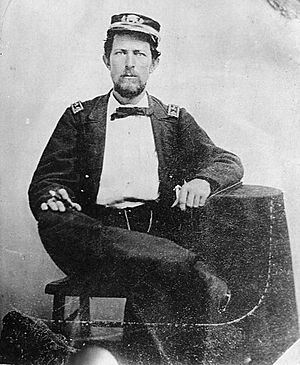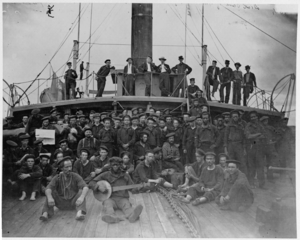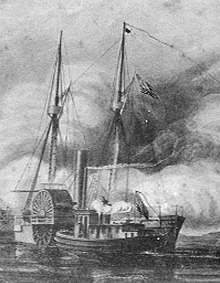Joint Expedition Against Franklin facts for kids
Quick facts for kids Joint Expedition Against Franklin |
|||||||
|---|---|---|---|---|---|---|---|
| Part of the American Civil War | |||||||
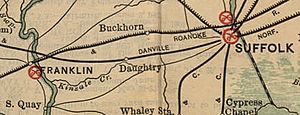 Extract from 1892 map of the subject area. The Blackwater River flows north-south in left of the image. |
|||||||
|
|||||||
| Belligerents | |||||||
| Union Navy Union Army |
Confederate States Army | ||||||
| Commanders and leaders | |||||||
| C. W. Flusser Edmund R. Colhoun Charles A. French Samuel P. Spear |
Dennis Dozier Ferebee J. K. Marshall Edward Graham Collet Leventhorpe |
||||||
| Strength | |||||||
| 3 Gunboats 1,300 Infantry w/1 × Artillery section |
10,000–12,000 Infantry | ||||||
| Casualties and losses | |||||||
| 5 KIA, 21 wounded | estimated 70–100 | ||||||
The Joint Expedition Against Franklin was a battle during the American Civil War. It involved both the Union Army and Union Navy fighting against the Confederate States Army. The main goal was to move Union forces into an area where Confederate soldiers were gathering. These Confederates were getting ready to attack Suffolk, Virginia.
The plan was for Union ships and soldiers to attack Franklin, Virginia together. But there were communication problems. The Union Navy started their part of the mission before the Army was ready. So, on October 3, 1862, Union Navy ships on the Blackwater River faced many more Confederate soldiers than they expected. They were forced to retreat. This naval battle is also known as the Action at Crumpler's Bluff or the Battle of Crumpler's Bluff.
At the same time, a Union Army scouting team tried to attack Franklin. They thought the Navy ships they heard nearby would support them. But they didn't know the ships were already retreating. In the end, the Union forces had 5 soldiers killed and 21 wounded. After the battle, Union Navy officers wondered if their gunboats were useful in joint missions if they couldn't protect themselves.
Contents
The Franklin Expedition
Why the Battle Happened
In early September 1862, the Confederate States Army's 4th North Carolina Cavalry moved to Franklin, Virginia. They were joined by other Confederate units, including the 52nd North Carolina Infantry. Their first big job was to build a pontoon bridge (a floating bridge) across the nearby Blackwater River. This bridge would help them move soldiers and equipment into Franklin. Colonel Dennis Dozier Ferebee, who led the 4th NC Cavalry, reported the bridge was finished on September 18.
A small Union Army cavalry group was in nearby Suffolk, Virginia. They were led by Major General John J. Peck. On September 23, Peck sent Colonel Samuel P. Spear to scout Franklin and see what the Confederates were doing. Colonel Spear reported back that the Confederates had built a new bridge that could hold cannons. He also estimated that there were 10,000 to 12,000 Confederate soldiers there.
General Peck shared this information with his boss, Major General John Adams Dix. General Dix then planned a two-part mission. The goal was to drive the enemy out of Franklin and destroy their floating bridge. The Union Army and Navy would work together.
General Dix asked for help from the Union Navy. Acting Rear Admiral Samuel Phillips Lee sent orders to Lieutenant Commander C. W. Flusser. Flusser was told to help General Dix with his plans. Three United States Navy steam-powered ferryboats were sent from Albemarle Sound. These were the USS Commodore Perry, led by Lieutenant Commander Flusser, the USS Hunchback, and the USS Whitehead.
Union scouts had reported on the Confederate positions in Franklin. Because of this, Generals Peck and Dix thought it would be smarter to wait for the joint attack. However, General Dix's message arrived five hours late. So, Commander Flusser never got the message that the Army was delaying their attack until around October 10. General Peck did order a scouting mission in the area. At 9:00 p.m. on October 2, Colonel Spear left Suffolk with 1,300 soldiers and one artillery section. His orders were to check out Franklin and see how many Confederate forces were south of Suffolk.
The Attack Begins
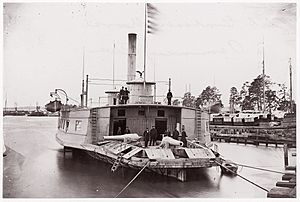
On the evening of October 2, Confederate lookouts saw the three Union riverboats waiting near South Quay, Virginia. This was about 3 miles downriver from Franklin. At 5:45 a.m. the next day, the three ships started moving towards the city. They fired their cannons at the riverbanks as they went. The Commodore Perry led the way, followed by the Whitehead behind the Hunchback.
While the Union ships fired at the banks, Confederate troops spread out along the riverside. They used the trees and bushes for cover. Some of the 4th North Carolina Cavalry soldiers got off their horses. They joined Colonel Marshall's 52nd Infantry. These soldiers were placed at Crumpler's Bluff and nearby cliffs to shoot at the riverboats. Colonel Ferebee took the rest of the 4th NC Cavalry. They also got off their horses and hid behind trees and bushes along the Blackwater's banks.
At 7:00 a.m., about 0.75 miles from Franklin, the Commodore Perry came under fire from the Confederate forces. The ship was too close to use its biggest cannons effectively. Commander Flusser told his sailors to find cover while the ship tried to pass the enemy. Because the river bend was narrow, the Commodore Perry got stuck on the river bottom.
After getting free, the Perry went around the bend. It then fired its guns to help the Hunchback and Whitehead follow. The combined firing from all three ships forced the Confederate soldiers to pull back from the riverbanks. However, the ships' progress was soon stopped by a barrier in the river. Commander Flusser had enough men to remove the barrier. But he couldn't try because of the "terrible fire" they were facing. The three ships kept firing their cannons and muskets at the Confederates. They waited at the barrier, hoping to hear the sound of General Dix's infantry forces.
At 10:15 a.m., Commander Flusser ordered the ships to retreat from the river barrier. All three ships remained under heavy fire from the enemy until between 2:30 and 3:30 p.m. A partial barrier of fallen trees did not stop the ships. They "pushed through" with a lot of steam power. Flusser later said that this new barrier would have been impossible to pass if the ships had waited longer for General Dix's forces.
Meanwhile, Colonel Spear arrived around 1:00 p.m. He expected support from the naval ships, but they were already retreating. His Union soldiers fought the Confederates in Franklin. After six hours of fighting, they were running low on ammunition. Colonel Spear also realized he only had 1,300 men, not the 1,700 to 2,000 he thought. He also lost two riflemen who left his side. So, Spear pulled his Union forces back from Franklin and returned to Suffolk. They left behind one brass field cannon, some coats, and a horse.
What Happened After
When they returned to Albemarle Sound, Commander Flusser sent the Hunchback to Plymouth. There, they buried the sailors who had died. At Roanoke Island, Flusser borrowed the USS Emily to take the wounded sailors to Norfolk Hospital.
What Was the Outcome?
The Confederate forces around Franklin successfully stopped the Union Navy. They eventually forced both the Navy and the Army scouting team to retreat. The Union Navy didn't lose any ships. But they had four sailors killed and 15 wounded. The Army had one soldier killed and six wounded. General Dix believed the Army had killed 70 to 100 Confederate soldiers in return.
For the Confederates, this was the 4th NC Cavalry's first battle of the war. It gave Colonel Ferebee and his men confidence. They and the other Confederate forces in Franklin spent the rest of October 1862 watching the Union forces across the river. After the Union shelling, most of Franklin's citizens left the town. They didn't return until after General Lee surrendered in April 1865. The Joint Expedition is described as the only important fighting in Southampton County, Virginia during the war.
Several Union servicemen were awarded the Medal of Honor for their brave actions in the battle. These included Thomas Barton, John Breen, James H. Burbank, Daniel Lakin, Alfred Peterson, Edwin Smith, and John Williams. Acting Rear-Admiral Lee praised Commander Flusser. He said Flusser showed his usual bravery. He also said the officers and crews of the three gunboats did their jobs well, even in very difficult situations.
In his report to Admiral Lee on October 6, 1862, Lieutenant Commander Flusser said his losses were heavy. He thought it was "foolish to fight these people on the banks, where they have every advantage." He also felt he couldn't help the Army forces any further. After the failed mission, both Navy and Army leaders suggested that trying to work together caused problems. Admiral Lee wrote to Naval Secretary Gideon Welles that "where the situation does not allow [...] gunboats to take care of themselves, they can not assist the army." General Peck also wrote to General Dix, saying, "there is great uncertainty in operations with gunboats."


